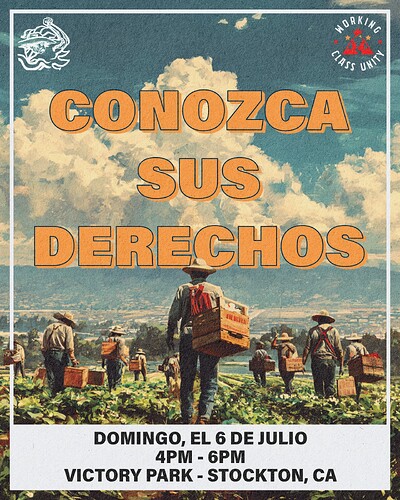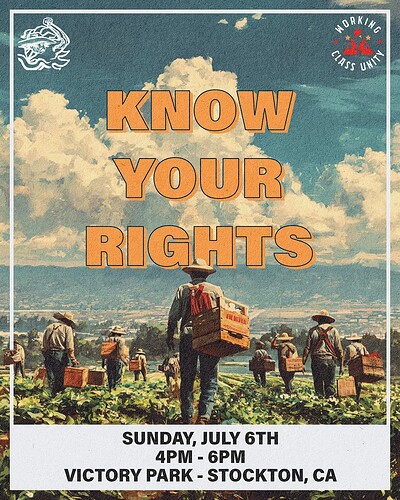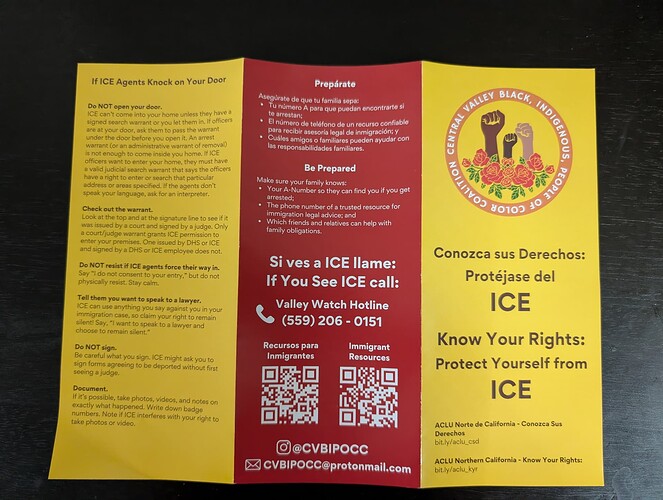Apologies for taking so long to get this up after the meeting, but here's a summary of the meeting we had with Luis and a few other people earlier this week.
We got a bit off topic from the agenda that we originally planned. On a side note, we were asked to make agendas for future meetings as well, especially as we invite other organizations, to ensure the meeting does not get hijacked by the local nonprofits or other interests.
Meeting Summary
Current Limitations and Critiques
We began the meeting with an assessment of the current rapid response infrastructure, particularly Valley Watch Network’s limitations. While it does appear that Valley Watch has lawyers with some access to the detention facility, their response system lags behind active events. The incident two weeks ago also highlighted how only arrests that are videotaped and spread through social media or activist circles receive attention and legal support. There were 15-20 other detainees at the Stockton processing facility who appeared to not be receiving any assistance because no one was aware of them.
Valley Watch’s Signal chat for San Joaquin County consisted of only 16 people when we checked during the meeting. Even if we increase that by 3x, it’s insufficient coverage for such a large geographical area. So our focus was on addressing the capacity limitations without just relying on asking more people to join Valley Watch.
Proposed Rapid Response Enhancements
To address these gaps, while taking into account our own limited capacities, we proposed two ways to add to what Valley Watch is currently doing:
Educational Materials
We proposed creating the following educational materials:
- Materials teaching the public how to recognize ICE vehicles and agents, which should reduce false reports and may also increase more positive reports.
- Materials on properly and safely recording ICE encounters, since most likely it will be bystanders, not trained observers, that will typically be on scene.
Rapid Response
We proposed a dual track approach for rapid response.
- For non-emergency sightings where no one is in immediate danger, we would ask people to continue reporting directly to Valley Watch. We do not have the capacity to deal with verifying possible false-reports.
- If someone is witnessing ICE actively arresting someone or coming to their home/workplace, they would text us their location. We would forward this to Valley Watch while simultaneously alerting rapid response subscribers in the appropriate zip code.
This should allow us to fill the gap of being able to respond faster, and in larger numbers, to active arrests. If we do receive false-positive reports, limiting the text blast to people in the same zip code should reduce inconvenience caused to rapid responders.
Communication and Alert System
The technical infrastructure would run through solidarity.tech for the most part. Community members can text us a keyword to receive information and subscribe to alerts. The system would collect minimal information - name (not necessarily legal or real name), phone number (already captured through texting), a zip code for geographic alert targeting. Subscribers could choose what types of information they want: rapid response alerts, resource updates, training announcements, or assistance requests.
For emergency alerts, we would only notify people within the affected zip code to ensure timely response and minimize unnecessary panic. The challenge will be in balancing immediate emergency response with avoiding alert fatigue from too many false alarms.
Accompaniment Education and Facility Monitoring
Another major proposal was establishing a permanent presence at Stockton’s ICE facilities for two reasons: so we can track when people are being brought into the facility and so we can assist both family members and people coming in for appointments.
Accompaniment Educational Materials
We proposed creating educational materials for accompaniment that would allow people who have an appointment to recruit family/friends to accompany them. With the number of people that are going in, in additional to the language barrier, this made more sense than trying build up this capacity internally.
Facility Monitoring
This would be our biggest task. We would establish a presence at Stockton’s ICE facilities. We would maintain a presence outside, offering resources to families searching for detained loved one. This addresses situations like people who came from Sacramento searching for their family member, only to discover the system had showed incorrect location information.
We would provide several services: helping people navigate the detainee locator system, identifying case officers and their contact information, and offering basic accompaniment support. They would record names, A-numbers, lawyer contacts, and emergency contacts of people entering for check-ins, promising to alert their contacts (and our rapid response) if they do not emerge. This create a form of “accompaniment-lite” for the people who do not have someone to accompany them.
Security and Operational Concerns
Which moves us into discussions around security. ICE agents have been confronting people recording or even standing near facilities, so there is awareness that volunteers will likely be identified and potentially surveilled. We agreed on the need for a buddy system, with minimum two-person teams at all times for facility monitoring. While some people suggested extensive disguise, others argued this could create barriers to participation and draw more attention from ICE. The end goal is to help people coming into the facility and no matter what precautions are taken, anyone that signs up should expect to be known to authorities if they participate with any regularity.
Another challenge was around community members’ increasing fear of recording any ICE activities, even when driving by. Many worry that documenting arrests could make them targets for retaliation, even if they are citizens. Hopefully, our above strategies will address this through safety in numbers - if more people know how to properly record and do so, individuals may feel less exposed.
For digital security, solidarity.tech should be considered compromised since it relies on SMS and cell phone for contact. It is also hosted domestically. However, for all our other data storage, information will be hosted on servers outside the country.
Legal Documentation
We are creating documentation instructions for things like power of attorney forms, emergency contact information, and childcare plans. Ideally, we would combine document preparation with in person Know Your Rights trainings, with a notary present, to fill out all paperwork right then and there. For documents that do not require a notary, there is an option to have people fill them outline and have them stored on our server.
Outreach and Network Building
The campaign overall requires extensive ground level organizing through multiple channels.
Canvassing
It was recommended that at the end of the day, printed materials will be the best way to spread information. So we will need to do a door-to-door canvassing operation while keeping track of which doors were visited while also tracking if anyone there asked for additional information / resources / training. We should also provide tenant union outreach materials. Even if people know how to protect themselves from ICE, we are already hearing stories of landlords using people’s legal status against them.
Networking
We should also use community notes like vendors, churches, workplaces, parent group meetings at schools, and other neighborhood leaders who can distribute materials and information to their networks. If they trust us enough, we can also hold KYR trainings with smaller groups of people that they can bring together.
Public facing organizing
We discussed balancing public facing organizing with security concerns. While some strategic discussions should remain private, most activities like canvassing planning, resource development, and recruitment should be open to build trust and encourage participation. The goal is to create multiple entry points for community members with varying comfort levels and capacities, and encouraging a town that does not usually participate in work like this to step up.
Public facing organizing would include being much more transparent and public about upcoming plans/events, having open meetings while we are working on materials/planning, and holding more of those meetings at least hybrid at Odd Fellows.
We also planned to hold meetings every two weeks that would be open to everyone to attend.
Community Patrols, Neighborhood Watches
Beyond rapid response, we also discussed the possibility of establishing regular community patrols to help people feel safer while conducting daily activities. Right know, people are contacting folks they trust asking if its okay to go to Food4Less, for example, but it is difficult for one person to say one way or the other.
So we discussed the possibility of maintaining a presence at key locations like grocery stores, schools, and other gathering places. Unlike rapid response, which reacts to ICE presence, the goal here would be to provide ongoing reassurance that ICE is not present and an early warning system that people can check in with. The key would be to have a few people provide reassurance to a broader number of people.
We also discussed establishing neighborhood watches, but we did not really go into detail for that.
Next Steps and Implementation
The next meeting was scheduled for August 8th (so we need to reschedule New Member Orientation).
The immediate priorities include finishing our KYR/training materials, creating the rapid response training videos, and establishing the text alert system since that has already been voted and approved.
Beyond that, at the next General Meeting, we will likely have to vote on shifting this work into our second Focus Campaign, especially if we want to do the field presence, canvassing, ongoing meetings.



